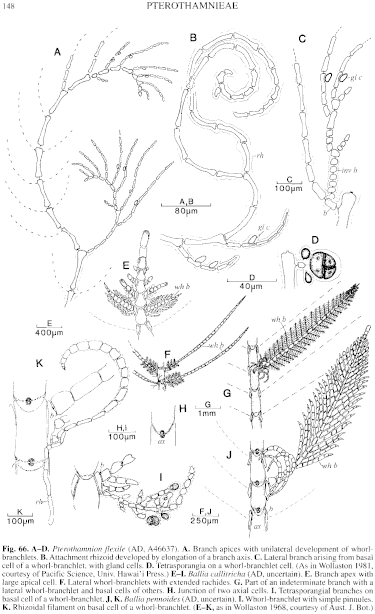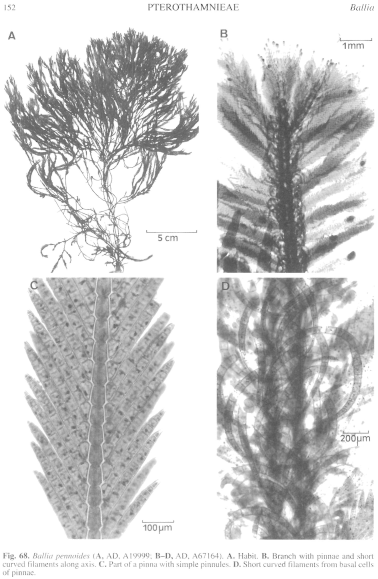|
|
|
|
|
|||||||||||
|
Electronic Flora of South Australia Species Fact Sheet
Phylum Rhodophyta – Order Ceramiales – Family Ceramiaceae – Tribe Pterothamnieae
Thallus (Fig. 68A) dark red-brown, erect, 10–25 cm high, much branched with long laterals, complanately branched above, densely corticated on central and lower axes which become denuded. Holdfast rhizoidal, conical to rounded, 0.5–2 cm across; epilithic. Structure. Apical cells prominent, 90–120 µm in diameter and L/D 1–2.5, enlarging gradually to 150–200 µm in diameter and L/D 1.5–2.5 in lower axes, cells with relatively transverse upper and lower end walls, pit-connections prominent and umbonate, each cell with two opposite whorl-branchlets. Corticating rhizoids produced from basal cells of whorl-branchlets (Fig. 66K), cells long and 20–30 µm in diameter, forming a compact, adherent, cortical layer on lower axes; basal cells and rhizoid cells also producing an outer cortex of short, curved, simple branches (Fig. 68B, D). Whorl-branchlets (Fig. 68B, C) 2–6 mm long, pinnate with closely adjacent, simple, pinnules (Fig. 66J), basal cells of rachis elongate along the axial cell, suprabasal cells 50–70 µm in diameter and L/D 1–1.5, tapering to apical cells 18–22 µm in diameter, mucronate and L/D 1.5–3; basal cells of pinnules broad based, upper cells 25–35 µm in diameter and L/D 1–1.8, tapering above to mucronate terminal cells. Lateral branches originating on axial cells at irregular intervals. Cells uninucleate; rhodoplasts discoid in smaller cells, in chains in larger cells.
Reproduction: Unknown.
Type from Robe, S. Aust., drift (Wollaston, 14.xi.1955); holotype and isotypes in AD, A19999.
Selected specimens: Stinky Bay, Nora Creina, S. Aust., drift (Wollaston, 27.i.1969; AD, A33394) and 6–8 m deep (Hotchkiss, 28.x.1996; AD, A69164). 1.3 km off Cape Northumberland, S. Aust., 14 m deep (Shepherd, 13.iii. 1975; AD, A46164). Port MacDonnell, S. Aust., upper sublittoral pools (Womersley, 25.i.1967; AD, A31688). Marrawah, Tas. (E & G. Perrin, March 1950; AD, A49635 and BM). Fluted Cape, Bruny I., Tas., 10 m deep (Shepherd, 12.0.1972; AD, A42005).
Distribution: Robe to Port MacDonnell, S. Aust., and probably around Tasmania.
Taxonomic notes: B. pennoides is closely related to B. callitricha, differing in having simple pinnules in contrast to the pinnate pinnules in the latter. It is far less common than B. callitricha but probably more widespread than records indicate.
References:
WOLLASTON, E.M. (1968).Morphology and taxonomy of southern Australian genera of Crouanieae Schmitz (Ceramiaceae, Rhodophyta). Aust. J. Bot. 16, 217–417.
The Marine Benthic Flora of Southern Australia Part IIIC complete list of references.
Publication:
Womersley, H.B.S. (24 December, 1998)
The Marine Benthic Flora of Southern Australia
Rhodophyta. Part IIIC. Ceramiales – Ceramiaceae, Dasyaceae
©State Herbarium of South Australia, Government of South Australia
Illustrations in Womersley Part IIIA, 1998: FIGS 66J, K, 68.

Figure 66 enlarge
Fig. 66. A–D. Pterothamnion flexile (AD, A46637). A. Branch apices with unilateral development of whorl-branchlets. B. Attachment rhizoid developed by elongation of a branch axis. C. Lateral branch arising from basal cell of a whorl-branchlet, with gland cells. D. Tetrasporangia on a whorl-branchlet cell. (As in Wollaston 1981, courtesy of Pacific Science, Univ. Hawaii Press.) Ballia callitricha (AD, uncertain). E. Branch apex with large apical cell. F. Lateral whorl-branchlets with extended rachides. G. Part of an indeterminate branch with a lateral whorl-branchlet and basal cells of others. H. Junction of two axial cells. L Tetrasporangial branches on basal cell of a whorl-branchlet. J, K. Ballia pennoides (AD, uncertain). I. Whorl-branchlet with simple pinnules. K. Rhizoidal filament on basal cell of a whorl-branchlet. (E–K, as in Wollaston 1968, courtesy of Aust. J. Bot.)

Figure 68 enlarge
Fig. 68. Ballia pennoides (A, AD. A19999; B–D, AD, A67164). A. Habit. B. Branch with pinnae and short curved filaments along axis. C. Part of a pinna with simple pinnules. D. Short curved filaments from basal cells of pinnae.

|
Email Contact: State Herbarium of South Australia |

|